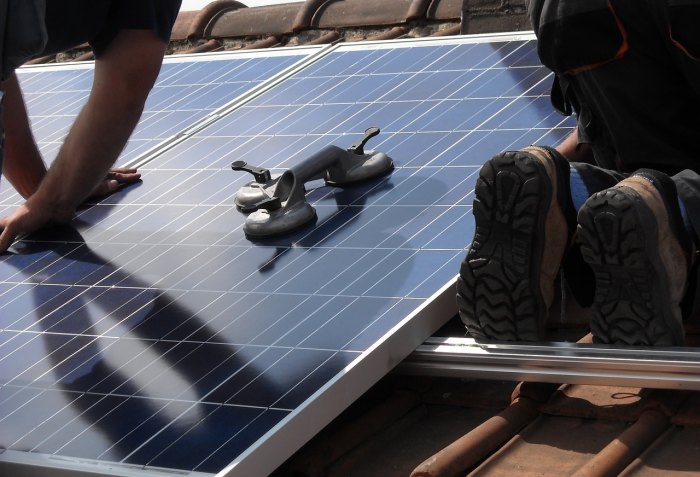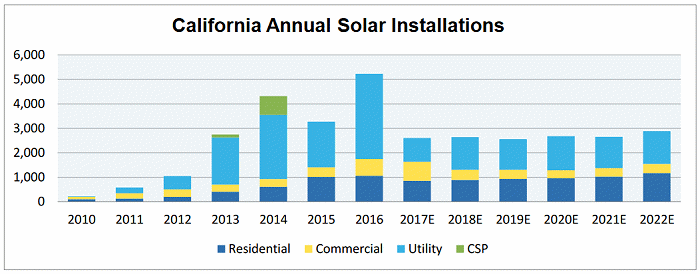
It’s widely expected a vote later this week on making solar power compulsory for new homes in California will pass muster.
On May 9 (local time), the California Energy Commission will hold a hearing for possible adoption of its 2019 Building Energy Efficiency Standards.
These include a directive that starting in 2020, virtually all new houses, condos and apartment buildings less than three storeys in the state will require solar power systems as part of the building package. There will be exceptions or alternatives permitted in cases where shading issues make PV not viable.
The cost of solar in Australia is far cheaper than in California, so the requirements will add a hefty figure to build costs. However, emissions reductions aside, it’s said the savings will still greatly outweigh the expense over the life of these systems.
The Mercury News reports the new energy standards will whack on around USD $25,000 to $30,000, with solar accounting for around half of the cost. The standards, it states, will result in $50,000 to $60,000 in reduced operating costs over 25 years.
That really doesn’t sound all that attractive when taking into account loan interest and compared to a term deposit, but I haven’t crunched the numbers. Australians certainly get much better bang for their solar buck, particularly given our electricity prices are significantly higher than in California.
California A Solar Powerhouse
Even without this initiative, California is no slouch on the solar front.
According to the Solar Energy Industries Association (SEIA), California has more than 21 GW of solar capacity installed and ranked no.1 in the nation in 2017. Last year 15.56% of the state’s electricity was from solar energy.
In terms of home installations, 5,441,189 Californian households have solar panels.

Image: SEIA
SEIA forecasts 13,402 MW of capacity (residential, commercial, utility and CSP ) to be added in the state over the next 5 years.
Mandatory Solar In Australia
While there’s nothing similar on the horizon for any state in Australia, a report released in February by the Australian Sustainable Built Environment Council (ASBEC) and ClimateWorks Australia recommended solar panels (or other renewables) should be compulsory for new homes built here.
At a more local level, rooftop solar power is already mandatory in the suburb of Denman Prospect in the ACT. In Western Australia, the City of Nedlands council voted to make solar or other on-site renewable energy generation compulsory for new residential dwellings in 2014.
Last month, Wollondilly Shire (New South Wales) Deputy Mayor Robert Khan said he wanted to see solar panels compulsory for all new residential housing developments in his region and would raise the issue at this month’s council meeting.

 RSS - Posts
RSS - Posts



I’m in two minds whether compulsory domestic PV is a good thing. While I would generally like to see PV on as many rooftops as possible, I have a fear (and perhaps an irrational one) of the unintended consequences. I’m thinking back to the unintended consequences of the home insulation scheme – insulation in every rooftop in and of itself is almost certainly a good thing but rapid stimulation of a new lucrative business opportunity requires some very careful thought.
I expect that a goodly proportion of rooftops would support PV installation, but there are bound to be a handful that are poorly oriented or that have bad shading problems. Should panels be installed in the shade simply for compliance purposes? I’m sure many of us have seen some badly planned installations and it bothers me greatly – I would actually like to see unethical installers have their accreditation revoked for selling unworkable systems to consumers!
The “or other” part of the Nedlands decision bothers me a bit because I expect “other” invariably means small wind – and I would imagine close to 100% of these are unworkable systems in urban areas.
I’m sure all of this could be solved if some clever people had enough time to think things through first, and I hope this happens as part of the process.
Some of the problems with mandatory solar can be overcome by using a point system. A new home must have a certain number of points and get get them in different ways. For example, good insulation would be worth a certain number of points, a rainwater tank another amount, and so on. This way it might make sense for most homes to install solar but if for some reason rooftop solar wasn’t suitable or people just don’t want it they could make it up in other ways.
But I have to admit the dollar figures given in this article seem crazy high. A lot more environmental benefit could be gained by using the money to directly build solar and wind farms.
“In terms of home installations, 5,441,189 Californian households have solar panels.”
Out of how many (what is the total number of dwellings in California?) total households?
Wikipedia says
“With 39.5 million residents, California is the most populous state in the United States ”
So, I am wondering how the various statistics for California, in terms of adoption of domestic rooftop photovoltaic systems, relative to the population numbers, compares with the various states (and country) of Australia, with California having almost twice the population of Australia.
I note also, that, whilst the article refers to the cost comparisons of domestic rooftop photovoltaic systems between Australia and California (but, not the cost comparisons by kW capacity; eg, $1000/kW), California is pretty well off, compared to Australia (from memory, California has the fifth biggest economy in the world), and they are very much richer than the undeveloped country of Australia, which can’t even afford a reliable telephone network.
Wikipedia says
”
California’s $2.75 trillion economy is larger than that of any other state. If it were a country, California would be the 5th largest economy in the world,
”
So, they could probably afford to pay about a million dollars, to put a solar system on each of their mansions, and still have enough spare money to buy an Australian state (is Elon Musk a Californian?)
I have just checked, and, yes, surprise, surprise, Elon Musk IS a citizen of California, and his net worth is about 20 USA billion USD (in real terms, 20 thousand million USD, as a real billion is a million million).
So, he can afford to buy Australia, and have change left over to buy one of those Tesla luxury cars, and a Tesla truck to transport it in, when its battery goes flat out, on the Nullarbor, whereas an average Californian can probably only afford to buy a state of Australia.
Ah, that should have been, “when the car’s battery goes flat, out on the Nullarbor”. If the car goes flat out, on the Nullarbor, its battery will go flat, even more flat out, out on the Nullarbor. And then, the wombats chasing it, would be able to catch it.